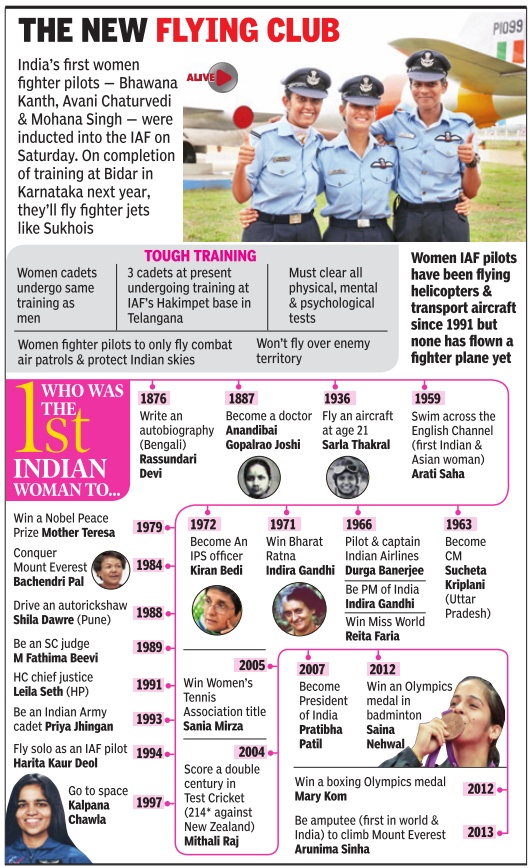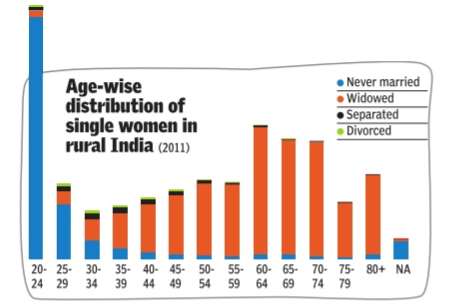Women, the status of, in India

This is a collection of articles archived for the excellence of their content. |
Contents[hide] |
Single women in India


Indian women: a socio- economic profile
2001-11
The Times of India, Dec 19 2016

More married women at work than single: Census
Subodh Varma How does marriage af fect a woman's job pro spects, and later, how does she negotiate issues like the number of children and their gender? Recently released Census 2011data offers some interesting insights. Among those in the childbearing age of 15-49 years, married women are more likely to be working than unmarried women. Those with regular jobs are also likely to have fewer children. But there is a downside to this: with fewer children, the preference for a son becomes an overriding factor, causing a fall in the sex ratio. The lot of nonworking women, who make up the majority , is no better.Confined to “domestic duties“, they not only have more children than working women, the sex ratio among their children is much worse, indicating a stronger stranglehold of patriarchal values.
In the child-bearing age group, just 27% of unmarried women are working compared with 41% among married women. Experts say that most unmarried women are young and families don't allow them to go out to work.Some are students in higher levels of school or college. The total fertility rate or average number of chil dren born to a woman over her full child-bearing years has dipped to 2.9 for working women from 3.3 a decade ago.
On the other hand, the fertility rate is higher at 3.1 among non-workers, only marginally down from 3.2 in 2001.In both cases, the sex ratio of children born in the last year is falling, but more so among working women -from 912 in 2001 to 901 in 2011. Among nonworkers, the sex ratio fell from 901to 894 in this period.
Marginal workers -women who have irregular or casual jobs for less than six months in a year -show the tense equation between a desire to limit children and son preference. The fertility rate is still high among them at 3.4 though down from 3.7 a decade ago. But the sex ratio has slightly improved from 911 in 2001 to 914 in 2011. Economic reasons may prevent such women and their families from accessing sex-selective abortions, often forcing more pregnancies in pursuit of sons. Also, underprivileged sections like tribals and Muslims form a larger chunk of marginal workers and sex-selective abortion is not as acceptable in these communities.
The wide chasm between urban and rural India is a striking feature of this data.Half of the married women in rural areas work while in urban areas just 22% go out for jobs. In urban areas, fertility rates have dropped drastically with women main workers having just 2 children on an average compared to 3.1 for their rural counterparts.
Side by side, sex ratio too has suffered a chilling decline from 936 to 906 for them, the biggest decline among all economic groups.
2005-16
Sushmi Dey, 53% of women have bank acs, up from 15% in 2006 , March 2, 2017: The Times of India


India has witnessed an impressive jump in financial inclusion of women, with 53% of the female population now having bank accounts as compared to a mere 15% a decade ago, according to the latest national family health survey.
The study made public reveals a heartening increase in the number of women operating their savings bank accounts, owning houses and participating in decision-making in households as well as opting for antenatal check ups and hygienic methods for protection during menstrual period.
The data also show that violence against married women has come down. The percentage of women facing marital violence has dropped from 37.2% to 28.8%. The survey also shows only 3.3% such women faced violence during pregnancy . This indicator seems to reflect a better awareness of their rights and improved social standing.
The 38% jump in women with bank accounts is complemented by the survey finding that 84% married women in the age of 15-49 years are increasingly participating in decision-making as compared to 76% in the third round of NFHS conducted in 2005-06. The data also show 38.4% of women own a house and or land -alone or jointly with others.
Not surprisingly , im provements in banking and an enhanced role in the household are accompanied by an increase in the female literacy rate that has gone up to 68.4% as compared with 55.1% in the pre vious survey . The female literacy rate, however, continues to lag men who have a literacy rate of 85.6%. Women with more than 10 years of schooling also grew from 22.3% to 35.7% between NFHS3 and NFHS4.
Women in the labour force: statistical profile, 2012-13
Population
As per Census 2011, workers constituted 39.79 per cent of total population whereas the ratio of female workers was 25.51 per cent. At All-India level the percentage share of females as cultivators, Agricultural labourers, workers in the household industry and other workers stood at 24.92, 18.56, 2.95 & 47.20 respectively. The percentage of female main workers to total female population stood at 25.5 which shows an increase as compared to 14.68 reported in the 2001 Census. Literacy rate amongst females was reported at 65.46 per cent which was less than the male literacy rate i.e. 82.14 per cent in the 2011 census. Work participation rate of female workers in rural areas was higher which stood at 30.0 as compared to the work participation rate of 15.4 per cent in urban areas. The State of Himachal Pradesh had the highest female work participation rate (44.8 %) whereas the lowest was reported in case of Delhi (10.6 %). Percentage of female main workers, female marginal workers and female other workers to total female population was 59.6, 40.4 and 29.2 respectively.
Employment
Average daily employment of women in factories was 15.65 percent during the year 2010. At State level, average daily employment of women in the factories for all groups was 7,42,701 during the year 2010. The majority of Women workers i.e. 4,82,779 worked above 45 hours and upto 48 hours per week in the factories during the year 2010. Share of women employment in coal mines was reported as 3.05 percent during the year 2010. The share of women employment in mines was 4.41 per cent during the year 2010. Among all the different mines groups the highest employment of women was reported in magnesite mines i.e. 40.26 per cent. Percentage share of women employment to total employment in all Plantations taken together was reported at 55.86 during the year 2010. In the Plantations sector, the average daily employment of women was highest (2,13,951) in Assam during the year, 2010.
Employment Service and Training
During the year, 2011 total number of women applicants on live register was reported at 13694.8 thousand which constituted 34.1 per cent of the total number of applicants on live register.
Proportion of educated women job-seekers to total women on live register was reported at 85.3 percent during the year 2011. Average daily wage rates of female workers for regular, casual in public works and Casual in other works is 249.51, 86.54 and 70.19 respectively. Percentage of placement to registration of women job-seekers has increased from 2.7 per cent in 2009 to 5.3 per cent in 2010. Among major states, Tamil Nadu reported the highest number of women job- seekers (540.1 thousand), followed by Kerala (264.6 thousand) whereas, the lowest number was reported from Arunachal Pradesh (3.4 thousand) at the end of 2011. Placement of women job-seekers was the highest i.e. 39.1 thousand in Gujarat at the end of 2011.
Wages & Earnings
At All-India level, wages/salaries per manday worked for directly employed women worker was reported at Rs. 145.63 whereas it is almost double for their men counterpart (Rs. 288.14) for the year 2009-10. The wages/salaries per manday worked for directly employed women workers were Rs. 328.74, Rs. 293.55 and Rs. 139.61 in Public sector, joint sector and private sector respectively, whereas for men workers it was much higher i.e. Rs. 619.86, Rs. 725.47 and Rs. 255.47 respectively during 2009-10.
Trade Unions
Percentage of women membership to total membership was reported at 37.5 per cent during the year 2010. Numbers of registered Trade Unions were 19,376 during the year 2010. Out of these only 2,937 unions submitted the returns. Percentage share of women to total membership of central unions and state unions was 35.21 per cent and 37.63 per cent respectively for the year 2010 and it was 36.57 per cent and 32.28 per cent respectively for the year 2009.
Social Security
During the year 2011, 44,693 establishments under factories and 3,119 establishments in plantations were covered under the Maternity Benefits Act. Of these, 14,275 factories and 1,620 Plantations submitted returns during the year, 2011. In factories 2,046 women and in plantations 29,123 women claimed maternity benefits during the year 2011. Total amount of maternity benefits paid in the factories and plantations was Rs. 12,15,42,972 and 4,77,72,200 respectively. Under the Factories Act, crèche facility was provided by 3,289 factories at all India level.